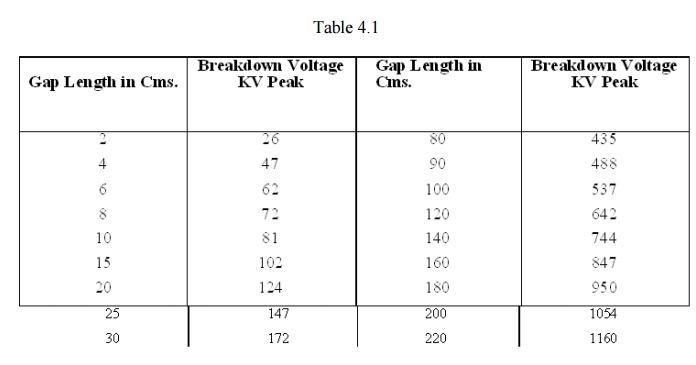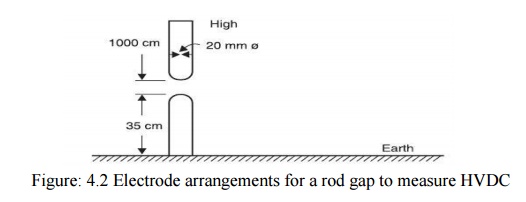A rod gap may be used to measure the peak value of power frequency and impulse voltages. The gap usually consists of two 1.27 cm square rod electrodes square in section at their end and are mounted on insulating stands so that a length of rod equal to or greater than one half of the gap spacing overhangs the inner edge of the support. The breakdown voltages as found in American standards for different gap lengths at 25° C, 760 mm Hg. pressure and with water vapour pressure of 15.5 mm Hg. are reproduced here.

The breakdown voltage is a rod gap increases more or less linearly with increasing relative air density over the normal variations in atmospheric pressure. Also, the breakdown voltage increases with increasing relative humidity, the standard humidity being taken as 15.5 mm Hg. Because of the large variation in breakdown voltage for the same spacing and the uncertainties associated with the influence of humidity, rod gaps are no longer used for measurement of a.c. or impulse voltages. However, more recent investigations have shown that these rods can be used for d.c measurement provided certain regulations regarding the electrode configurations are observed. The arrangement consists of two hemi spherically capped rods of about 20 mm diameter as shown in Fig. 4.3.1.

The earthed electrode must be long enough to initiate positive breakdown streamers if the high voltage rod is the cathode. With this arrangement, the breakdown voltage will always be initiated by positive streamers for both the polarities thus giving a very small variation and being humidity dependent. Except for low voltages (less than 120 kV), where the accuracy is low, the breakdown voltage can be given by the empirical relation.

Where h is the absolute humidity in gm/m3 and varies between 4 and 20 gm/m3 in the above relation. The breakdown voltage is linearly related with the gap spacing and the slope of the relation B = 5.1 kV/cm and is found to be independent of the polarity of voltage. However constant A is polarity dependent and has the values
A= 20 Kv for positive Polarity = 15 Kv for negative polarity
The accuracy of the above relation is better than ±20% and, therefore, provides better accuracy even as compared to a sphere gap.

